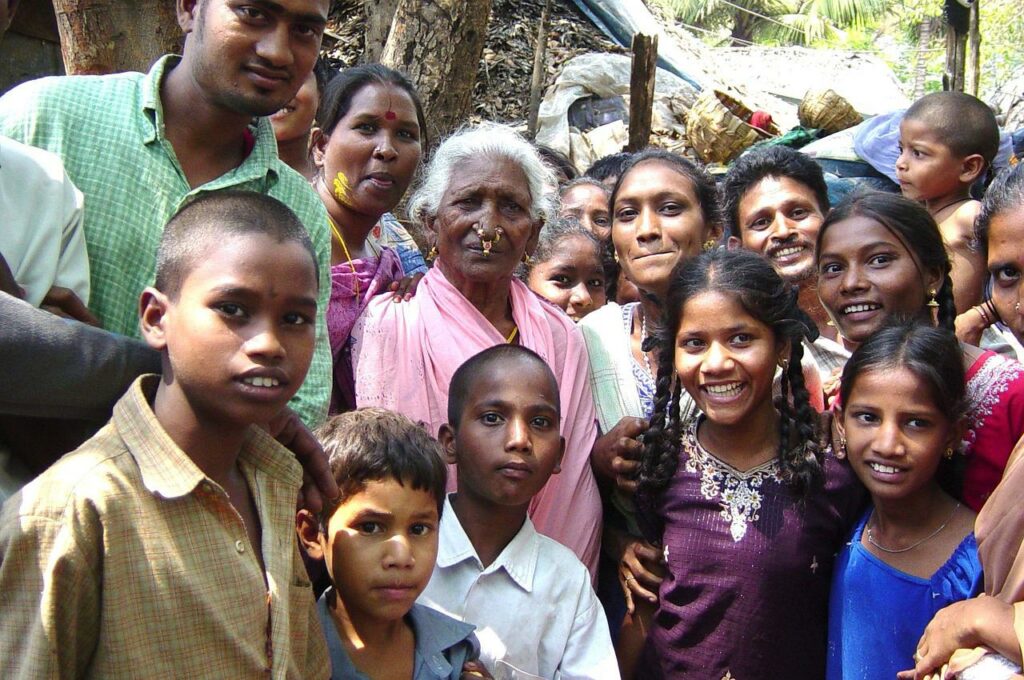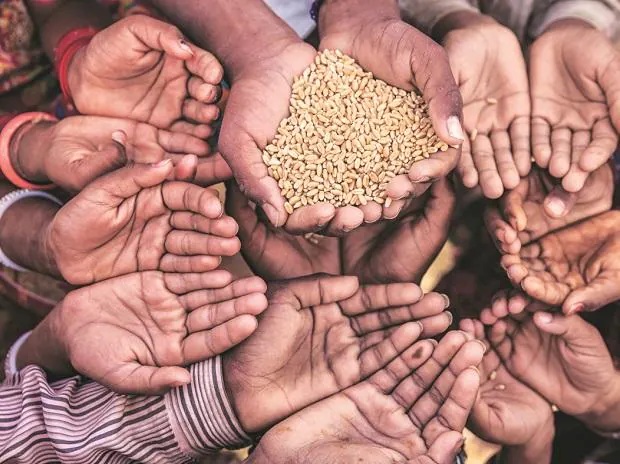|
Getting your Trinity Audio player ready...
|
Research papers by the IMF and World Bank find that Extreme Poverty has been eliminated in India on account of various fiscal and social security measures taken by the BJP Government under Narendra Modi since 2014.

- The research papers cover how the BJP government’s schemes such as Pradhan Mantri Garib Kalyan Yojana had been effective in providing food grains to the poor through the Public Distribution System during the pandemic.
- The incorporation of food subsidies by the BJP government into the calculation of poverty is that extreme poverty has stayed below (or equal to) 1% for the last three years.
- The World Bank policy research paper highlights that extreme poverty in India declined by 12.3 percentage points in 2019 compared to 2011.
- The World Bank paper further suggests that the decline has been sharper in rural India, where poverty declined from 26.3 percent in 2011 to 11.6 percent in 2019.
———–
‘Garibi Hatao, Desh Bachao’ which was the famous theme and slogan of Indira Gandhi’s 1971 election campaign has been used by the opposition parties during every election since the 70s. The slogan that shaped the outcome of so many elections is slowly and steadily becoming a non-issue, thanks to the BJP Government that has come into power in the centre in 2014 and getting stronger each year. A remarkable paper about India was released by the International Monetary Fund and World Bank a few days ago. Its findings are mind-blowing as it is about India’s success, and particularly that of the BJP government under the Prime Ministership of Narendra Modi. The paper concludes that extreme poverty has been eliminated on account of several schemes and relief measures brought out by the BJP Government.
The two research papers released, one by the International Monetary Fund and other by World Bank has reached the headlines in several national newspapers. The implications of these research papers are that extreme poverty has been virtually eliminated and further it has been illustrated with several facts and figures showing such decline. The first working paper by the International Monetary Fund talked about poverty reduction with extreme poverty being totally eliminated. The subsequent paper by the World Bank states that extreme poverty in India has declined by 12.3 percent points between 2011 and 2019. Both these papers have observed that the food transfers were instrumental in this regard. Further it also states that poverty reduction was higher in rural areas (declining from 26.3 to 11.6 per cent between 2011 to 2019 or 14.7 percentage point) than in urban areas (from 14.2 to 6.3 percent during the same period or 7.9 percentage point).
Paper 1: Working Paper published by International Monetary Fund titled ‘Pandemic, Poverty and Inequality: Evidence from India’ authored by Surjit S Bhalla, Karan Bhasin and Arvind Virmani
The paper is authored by a) Dr. Arvind Virmani – Indian Economist who was appointed as India’s representative to the International Monetary Fund in 2009 (when INC was in power in the centre). He had also worked at the highest levels in the Congress ruled Government as Chief Economic Advisor to Finance Ministry’s Economic Affairs Department which was under P Chidambaram; b) Surjit Bhalla – Indian economist, author, columnist, presently working as Executive Director for India at the International Monetary Fund (IMF) and c) Karan Bhasin – Economist from New York. He has worked with government agencies and multilateral institutions in the past.
This research paper caught my attention as it highlighted India’s achievement of eliminating extreme poverty. The research paper presents poverty estimates and consumption inequality in India for each of the years from 2004-05 through the pandemic year 2020-21. The research paper also includes in-kind food subsidies on poverty and inequality. It further covers how the BJP government’s schemes such as Pradhan Mantri Garib Kalyan Yojana had been effective in providing food grains to the poor through the Public Distribution System during the pandemic. Extreme poverty was as low as 0.8 percent in the pre-pandemic year 2019, and food transfers were instrumental in ensuring that it remained at that low level in the pandemic year 2020. The research paper has further said that the Government food rations can be and are an important source of income for the consumption expenditures of the poor in India. The food support rations has increased during the pandemic – the food grain ration was doubled for each recipient from 5 kg of wheat (or rice) per month to 10 kg in 2020. The Public Distribution System (PDS) of food has supplied subsidized cereals, sugar and kerosene to ration card holders.
The research paper has further said that the Government food rations can be and are an important source of income for the consumption expenditures of the poor in India.
The working paper relies on the data collected from the National Statistical Organization and PovcalNet is an interactive computational tool available to carry out calculations of poverty levels based on the World Bank’s researchers estimates and the extent of absolute poverty in the world. The same tool has estimated that there will be an increase of 97 million extreme poor worldwide in 2020 and a reduced 76 million in 2021 (that is the number of extreme poor decreased by 21 million in the second pandemic year 2021).
The present working paper is developed based on state-level GDP and population data, administrative data on various consumption items, several survey-based data and a verification provided on these estimates of per capita growth provided by data on national private final consumption expenditures. This data has been comprehensively analysed and the adjustments on poverty is striking. First, some base year household distribution was taken. This data is further processed using four household panels for all the years from 2004-05 to 2020-21. Then, the poverty line for each household is taken in different years including the rural and urban estimates, thereafter this data was merged with the base household data. Based on these data the following results were noticed:
- National accounts real per capita consumption growth has stayed relatively constant at 6.2% per annum.
- However, real per capita consumption growth grew at 5.9% per annum, 2014-19, higher than 4.0% growth experienced during the highest GDP growth period 2004-11. It is this consumption growth that is relevant for estimates of headcount poverty and inequality.
- A pointer to why this poverty decline during a lower GDP growth period (2014-19 vs 2004-11) has happened is provided by the steep decline in inflation – from a Compound Annual Growth Rate (CAGR) of 8.4% in the high GDP growth period to just 3.6% during 2014-19. Deflator inflation also falls, but not to the same degree (a decline of 3 percentage points rather than a decline of 4.8 percentage points).
By this analysis the surprising result from the incorporation of food subsidies by the BJP government into the calculation of poverty is that extreme poverty has stayed below (or equal to) 1% for the last three years. In the pandemic year 2020-21 extreme poverty was at its lowest level ever i.e., 0.8% of the population. While, as early as 2016-17 extreme poverty was at 2% level. Poverty in India registered at 14.8% in the pre-pandemic year 2019-20. The achievement is put in perspective by noting that in 2011-12, the official poverty level for the lower line was 12.2%. Extreme poverty (PPP$1.9 per person per day) was below 1% in 2019 and 2020 (pandemic year) in India. A low percentage in extreme poverty for 2 consecutive years is considered as elimination of extreme poverty!
Paper 2: ‘Poverty in India has declined over the Last Decade but not as much as previously thought’, by Sutirtha Sinha Roy and Roy van der Weide
Paper 2 was issued after Paper 1 was released by the IMF. The Paper 2 being the World Bank policy research paper which has been co-authored by economists Sutirtha Sinha Roy and Roy van der Weide, highlights that extreme poverty in India declined by 12.3 percentage points in 2019 compared to 2011 with poverty headcount rate declining to 10.2 per cent in 2019, and it further suggests that the decline has been sharper in rural India, where poverty declined from 26.3 percent in 2011 to 11.6 percent in 2019, the report said. Both rural and urban poverty dropped by 14.7 and 7.9 percentage points during 2011-2019.
The food subsidy program instead of increasing cash transfers enabled the government to provide free food as per average monthly requirement through the PDS system.

The paper also identifies that farmers with small landholdings witnessed higher income growth. Real incomes for farmers with the smallest landholdings have grown by 10 percent in annualised terms between the two survey rounds [2013 and 2019] compared to a 2 per cent growth for farmers with the largest landholding,” the paper said.
It is observed that there has been a slight moderation in consumption inequality since 2011, but by a margin smaller than what is reported in the unreleased NSS-2017 survey. Finally, the extent of poverty reduction during 2015-2019 is estimated to be notably lower than earlier projections based on growth in private final consumption expenditure reported in national account statistics.
The food subsidy program instead of increasing cash transfers enabled the government to provide free food as per average monthly requirement through the PDS system. This was further enabled by the Food Security Act and the increased use of Aadhaar accelerated the declining proportion of leakages in the program. Without any food subsidies, extreme poverty in the pandemic year would have increased by 1.05% (i.e., from 1.43% to 2.48%) and Lower Middle-Income poverty by 8% (i.e., 18.5% to 26.5%). The social safety net provided by the BJP Government in the expansion of India’s food subsidy program absorbed a major part of the pandemic shock. These programs acted as an insurance to the poor and prevented an increase in the prevalence of extreme poverty in India. This illustrates the robustness of India’s social safety architecture as it withstood one of the world’s biggest exogenous income shocks.
Pandemic relief was not only limited to ration distribution but also included automatic stabilizers such as reducing fees and penalties on non-compliance with regulations such as tax filings.
The implication provided by this research paper is that extreme poverty has been virtually eliminated. There are several other in-kind transfers such as the LPG subsidy and subsidy for use of electricity. In addition, asset transfers in the form of financial support for construction of toilets and affordable housing. It is also evident that the pandemic relief was not only was limited to ration distribution but also included: a) automatic stabilizers such as reducing fees and penalties on non-compliance with regulations such as tax filings, b) Target new expenditures and subsidies carefully to those who were most affected by the pandemic. This further restrained spending during the lockdown restrictions which enabled the fiscal resources to have the maximum multiplier impact, and c) coordinate with India’s central bank and provide monetary policy support.
To conclude hereby, we have this fantastic achievement of extreme poverty being eliminated. Moreover, it is sustained in the pandemic year. Pradhan Mantri Garib Kalyan Anna Yojana– food grains provided to the poor through India’s Public Distribution System and various other schemes that have been prevalent before and during the pandemic.
(The views expressed are author’s own)
